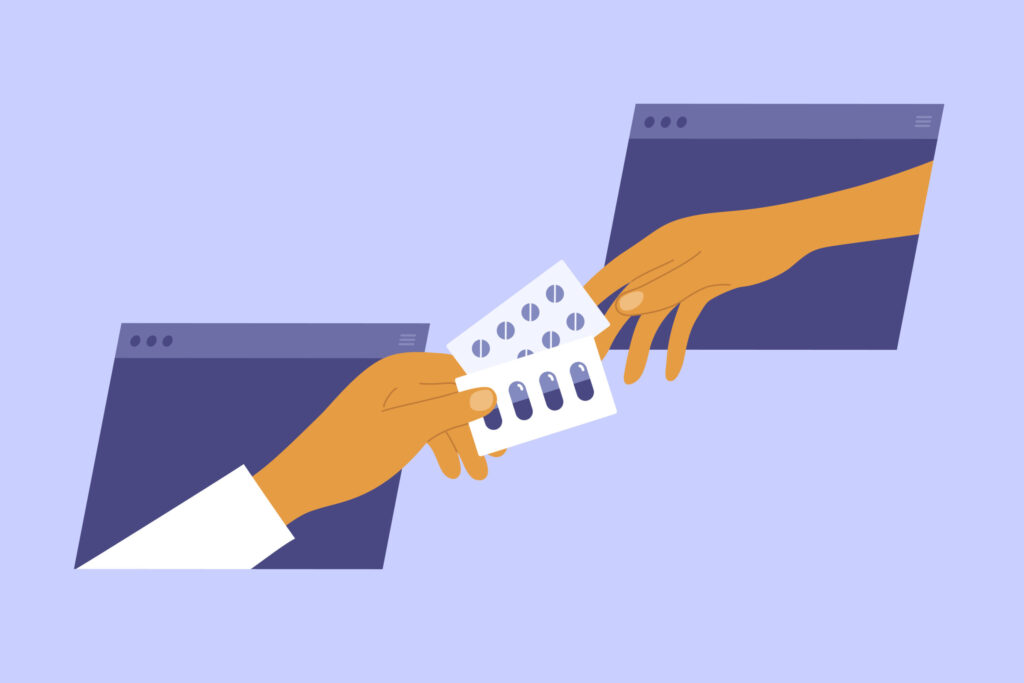26 days. According to a 2022 nationwide survey, it takes 26 days, on average, to schedule a new doctor’s appointment in 15 of the largest cities in the USA — up 24.1 days in 2017 and 21 days in 2004. In an increasingly digital-first on-demand world, where we can order same-day grocery delivery or get a cab in mere minutes using an app on our phones, healthcare has lagged, steeped in outdated and inefficient practices — but this dinosaur is now lumbering into the digital age.
There’s a transformation happening in healthcare, revolutionizing how and where people access medical care — consumers are turning the healthcare demand dynamic on its head. From virtual doctor visits to remote monitoring devices to online pharmacies, consumers increasingly demand healthcare experiences crafted with their needs and desires in mind, giving consumers options to connect and engage their health and wellness in a way that has the most benefit for them.
While this trend towards consumerization of healthcare has potential benefits for consumers, that’s largely because it may be filling the hole left by an American healthcare system fraught with challenges that include:
- Health insurance being tied to full-time employment
- Uneven access to care
- Gender and race disparities
- Lack of emphasis on preventive care
The American healthcare system leaves even the insured with burdensome challenges to care, with rising out-of-pocket costs and escalating deductibles. And add to that an aging population, which brings increased healthcare needs at a time when technology is also expanding into newer arenas. It’s a system geared more towards those who profit from it than it is to patients and doctors.
When it comes to health, age is not just a number. While companies are building end-to-end healthcare solutions that aim to provide convenient, personalized experiences leveraging advances in online retail and tech, there is the potential those who lean too far into consumerizing care may alienate the very folks who need it the most.
The Generational / Digital Divide
Health consumers are increasingly digital natives seeking convenient ways to access all aspects of their health and well-being. Millennials and Gen Z are more active consumers of online information and have greater digital expectations. They’re looking for that same personalized, consumer-first focus when it comes to their healthcare — from medications to therapeutics to actual care.
Perhaps unsurprisingly, only 55% of Gen Z’ers have a primary care physician or PCP, whereas 67% of millennials, 76% of Gen X’ers, and 84% of Baby Boomers have a PCP. Younger consumers like Gen Z and Millenials have expressed dissatisfaction with the quality and tenor of traditional healthcare services. As these younger generations get older and their medical needs grow, they increasingly look for options that satisfy their desire for convenience, efficiency, and transparency. Already, Millennials are twice as likely as Boomers to use telehealth and three times as likely to utilize wearable technology.
These generational rifts in thinking will increasingly put pressure on those delivering healthcare to consumerize their offerings further. As the younger generations become the core consumers, healthcare providers and organizations that do not move with the times will be left in the digital dust.
The Consumerization of Care
Companies are reading the room and seizing the chance to empower consumers to take charge of their well-being — and it’s not just limited to traditional healthcare providers. Concierge medical practices, retailers, health plans, and drugstores are all expanding what it means to provide care.
Even life sciences companies are (albeit more slowly) leaning into a more consumer-first model, given that 50% of people with chronic conditions don’t take their prescribed medications, and 33% of Americans can’t get the prescription medications they need because they don’t have a primary care provider. While more than half of healthcare consumers say they’re open to trying virtual care from a pharmaceutical company, life sciences companies are a few steps behind this growing consumer-first trend because they haven’t yet landed on a suitable service model.
The consumerization of healthcare is fast becoming a disruptive force, with individuals exerting more influence and control over their medical care. Companies across sectors as varied as tech, retail, and consumer packaged goods are now looking to address consumer and patient needs. This trend has indeed accelerated as people are more health conscious post-Covid.
Here are three significant ways that consumerized healthcare is coming to you:
1. Telehealth
Virtual doctor’s visits had a staggering 3,800% increase over their pre-Covid baseline, according to a McKinsey report, significantly eliminating the need for many in-person doctor visits and dramatically reducing patients’ average wait times to minutes. And for visits that need to be in-person, online check-in apps have significantly reduced wait time in germ-filled waiting rooms. For ongoing treatment and follow-up treatment, remote monitoring has further increased patient convenience.
COVID-19 invited a new age of telemedicine, with consumers and providers seeking ways to access and deliver medical care safely. By April 2020, overall telehealth usage was 78 times higher than in February 2020, with increased consumer and provider willingness to use telemedicine, along with regulatory changes enabling greater access to virtual models of care and, perhaps most importantly, reimbursement from the insurance side.
Today, telemedicine offers a chance for reinvention of virtual and hybrid (virtual/in-person) care models, which may help improve healthcare access and improve outcomes and affordability for all. Unsurprisingly, investment in virtual and digital health has skyrocketed — there was a 300% increase in VC money from 2017 to 2020 for digital healthcare start-ups, fueling ramped-up innovation in the space.
Virtual healthcare business models are evolving and proliferating, moving from just urgent care to encompass a wide range of services, including companies like direct-to-consumer (DTC) Hims & Hers, which focuses on mental health issues, hair loss, erectile dysfunction, and more. Hims & Hers, which went public two years ago, saw its top-line revenue jump 88% in the first quarter of 2023 to $191 million, up from $101 million a year prior, thanks to the strong growth of its multispecialty telehealth platform, in part due to their clever marketing campaigns that often use humor to engage their target market.
A notable portion of the company’s advertising spend is going towards celebrity endorsement agreements with partners such as Miley Cyrus. While the company tends to primarily promote Hims more than Hers — the partnership with Cyrus could mean the organization is ramping up its female-focused targeting.
Insider Intelligence eMarketer says that “Hims & Hers is becoming the model D2C healthcare brand to emulate. The company can afford to keep raising its marketing and advertising budget to acquire customers because of its engagement and retention rates.”
Hims & Hers sell their health and wellness products directly to consumers through their website, app, and to at least 13 retail partners like CVS, GNC, Walgreens, and Walmart — and they’re teaming up with Carbon Health to offer people in California direct access to providers for in-person health visits at clinics. Their clever ads have captured many a millennial heart that is starting to struggle with mental health and age-related issues.
2. E-pharmacies
Online pharmacies have been around for more than 20 years but really gained traction during the pandemic. Born initially out of convenience — and then during COVID-19, necessity — e-pharmacies, also known as digital pharmacies, have experienced dramatic growth, and it’s not hard to see why. They offer unparalleled accessibility, privacy, and price transparency — and yes, they’re exceptionally convenient.
25% of respondents to a survey conducted by the International Pharmaceutical Federation said that the most significant benefit of online pharmacies is improved access. Unlike brick-and-mortar retail pharmacies, digital pharmacies are available to nearly anyone with a Wi-Fi connection and come without the issues of distance or timing. With a reduction in travel costs as well, there can be significant savings for folks in rural communities without a nearby pharmacy, particularly those with chronic conditions.
Brands like Capsule capture market share by directly marketing to consumers, and it seems to be working. With taglines like “Meds made easy” or “A pharmacy nothing like a pharmacy,” the company offers free, same-day prescription delivery. It provides the option to privately chat or text with pharmacists if customers have any questions. Advertising and marketing are a big part of what has fueled the growth of companies like Capsule, shooting digital arrows through Millenial and Gen Z hearts.
Overall revenue for online pharmacies is forecast to reach $45.34 billion in 2023, and with a compounded annual growth rate of 12.41%, it is projected to reach $81.37 billion by 2028.
3. Wearable devices
The consumer wearable tech craze began in 2009, when Fitbit released its first fitness tracker, pioneering the category in the consumer space. You would clip the old-school Fitbit Classic to your waistband, and it tracked your steps, distance, estimated calories burned, and more. Since then, wearable technology has had explosive growth, providing athletes, regular folks, and healthcare professionals with detailed health information they can view at the tap-tap-tap of a smartphone.
Wearable tech has come to encompass any electric device worn on a user’s body, from new-gen Fitbits to smartwatches to Oura rings, which collect users’ biometric health, exercise, sleep, and other data, which can be sent to a user’s doctor or other healthcare professional in real-time. More and more Americans are using wearable health-tracking tech every day — with such quick adoption, it’s hard to say how we will use wearable technology even just ten years from now.
Oura has gained quite a following in the influencer-rich worlds of entertainment, sports, and business. From A-List actors like Jennifer Aniston and Gwyneth Paltrow to business titans like Arianna Huffington and Salesforce CEO Marc Benioff to more tabloid-friendly celebs like Kim Kardashian and Prince Harry. Part of the success of Oura’s marketing strategy has been to leverage these endorsements to gain earned-media exposure that resonates with its core audience of Millenials and Gen Z’ers.
Today, wearables have lunged past just measuring athletic performance, providing insights into many aspects of health and wellness, like sleep habits, stress levels, menstrual cycle trends, and more. The Ava bracelet tracks fertility and can predict ovulation by analyzing real-time data from heart rate, skin temperature, breathing rate, and more.
Growing demand for wearables has created a booming market, and insurers and companies are seeing the upsides of providing wearable health monitoring devices to their consumers and employees. With next-gen wearables capable of collecting health data they couldn’t before, like blood glucose and blood pressure, people can find information they previously got primarily at a doctor’s office or at home with specialized equipment.
The global wearable technology industry was valued at $54.8 billion in 2020 and is forecast to hit $184.4 billion by 2031, with a compound annual growth rate of 12.8% from 2022 to 2031.
__________________________________
Takeaway
Today, players in the healthcare space are taking their cue from consumer goods, e-commerce, and retail business leaders — and seek to craft long-term relationships with their consumers by speaking to them directly. With so much inherent dissatisfaction with healthcare in the USA, companies that can meet some of the unmet need have a big leg up on the competition because satisfied consumers are far less likely to switch horses midstream.
Here are some of the top reasons why this trend towards consumerization of healthcare has such long legs:
- Healthcare consumers are more empowered today than ever. Covid-19 forced medical care providers to pivot to digital care so they could continue delivering patient care. Telehealth emerged, seemingly overnight, from a burgeoning side note to the primary means by which patients could get non-critical care. And consumers experienced a retail revolution fueled by brick-and-mortar chains and e-commerce stores allowing for curbside pick-up or home delivery.
- There is a massive rethink happening for healthcare providers around how to grow and maintain continuity of care. Those who shifted tactics to focus on improving the consumer experience saw their revenue increase up to 20% over five years, with costs to provide the care decreasing by up to 30% — though it is unclear if any of these savings were passed down to consumers.
- Healthcare providers increasingly see marketing as a growth driver — elevating the need for cohesive strategic creative that drives growth. In this space, you need more than a catchy tagline (though it helps) — you need clarity of vision, strategic insights, and a team that can make a comprehensive 360-degree plan that engages consumers to think differently about their care by providing a full suite of consulting solutions.
If you’re looking to up your game and step boldly into this growing trend of consumerized healthcare but aren’t sure where to start, give us a call. We have ready-to-jump teams with the expertise to get your business where it needs to be.




